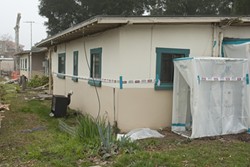[{
"name": "Ad - Medium Rectangle CC01 - 300x250",
"id": "AdMediumRectangleCC01300x250",
"class": "inlineCenter",
"insertPoint": "8",
"component": "2963441",
"requiredCountToDisplay": "12"
},{
"name": "Ad - Medium Rectangle LC01 - 300x250",
"id": "AdMediumRectangleCC01300x250",
"class": "inlineCenter",
"insertPoint": "18",
"component": "2963441",
"requiredCountToDisplay": "22"
},{
"name": "Ad - Medium Rectangle LC09 - 300x250",
"id": "AdMediumRectangleLC09300x250",
"class": "inlineCenter",
"insertPoint": "28",
"component": "3252660",
"requiredCountToDisplay": "32"
}]
On Feb. 12, construction crews broke ground on the first phase of a $95 million redevelopment of the Oak Park Affordable Housing Project in Paso Robles. Workers began demolishing a few of the decrepit World War II-era buildings that served as a barracks before their conversion into low-income housing in 1943.
One hundred and seven of the units remain rentable to qualifying families in what’s still the county’s largest low-income housing project. Construction on the new 302-unit complex, more than double the capacity of the old one, will begin later this year and will last five years. The site will also feature a 2.5-acre community park.
Paso Robles Housing Authority Executive Director Armando Corella characterized the existing apartments as unsalvageable and rattled off a laundry list of expensive problems, including tree roots growing into the plumbing systems. Buildings from this era, particularly those constructed at low cost, often also contain asbestos insulation and toxic paints.
“They’ve been around 72 years,” Corella said. “They’re old.”
The Housing Authority emptied 41 units of the existing apartments in 2010 with plans to start redeveloping Oak Park immediately, but failed to initially secure the low-income housing credits needed to finance the project. Landing a $3 million rural development loan from the U.S. Department of Agriculture last year helped the authority secure $16 million in low-income housing tax credits during the 2012 disbursement cycle.
Low-income housing credits originate with the Internal Revenue Service, but pass to the states for disbursement. States award the credits on a competitive basis to low-income-housing developers, who then sell the credits to private investors. Instead of a taxable cash return on their investments, the investors receive an annual credit to offset tax liability for a period of 10 years.
Any infusion of public capital in affordable housing developments goes a long way under the formula for allotting California’s scarce supply of tax credits. The Housing Authority also looked at the type of developments that often win credits and scaled back its redevelopment plans to make the project fit that mold.
However, it may prove difficult for the Housing Authority to collect the same amount next year. The presence of a nearby Scolari’s grocery store helped the Oak Park project land the credits in 2012, but the subsequent closure of the franchise may leave the Housing Authority a few points short in 2013. Unless another grocer moves into the neighborhood before March, the Housing Authority must find those points somewhere else.
“That’s our existence,” Corella said. “We have to fight and scratch for everything we have.”
Latest in News
Readers also liked…
-

Coast Unified teachers upset over new position's salary and qualifications
Oct 20, 2022 -

SLO police identify alleged driver who hit and killed couple
Dec 22, 2022 -

When the levee breaks: Oceano residents, county officials walk a tightrope of regulations to manage Arroyo Grande Creek, which some say led to the levee's failure in January
May 18, 2023







